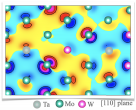
Scientists Make the First Observation of a Nucleus Decaying into Four Particles After Beta Decay
Scientists have observed a rare new radioactive decay mode for the first time. In this decay mode, oxygen-13 (with eight protons and five neutrons) decays by breaking into three helium nuclei (an atom without the surrounding electrons), a proton, and a positron (the antimatter version of an electron) following beta decay. The findings expand scientific knowledge of decay processes and the properties of the nucleus before the decay.

Researchers Test Quantum Theory with Precision-Engineered Thin Films
Comparing experimental results and theoretical calculations can be difficult for quantum materials. One solution is to use sample materials that isolate and emphasize an atomic line with one dimensional properties. In this study, scientists grew thin films of layered copper-oxygen materials to experimentally test theories of electron interaction in quantum materials. The study indicates that standard theory is not sufficient and requires a new term to fit the experimental data.

Transforming Cancer Diagnosis and Treatment with Cerium/Lanthanum-134
Actinium-targeted alpha radiotherapy is a promising approach for treating metastatic cancers, including prostate cancer. However, therapeutic substances labeled with actinium-225 have limits on how they can be imaged, a step that allows doctors to plan treatments. This study examined the performance of cerium/lanthanum-134 as a surrogate imaging material for Ac-225.

Calculations Predict Surprising Quark Diffusion in Hot Nuclear Matter
Tracking how high energy jets of quarks travel through the quark-gluon plasma (QGP) can reveal information about the QGP's properties. Recent theoretical calculations that include non-local quantum interactions in the QGP predict a super-diffusive process that deflects energetic particles faster than previously assumed. The discovery might help explain why the QGP flows like a nearly perfect liquid.

AtomAI Brings Deep Learning to Microscopy Data Analysis Software
Electron and scanning probe microscopes have become critical tools for condensed matter physics, materials science, and chemistry research.

How to Prepare your Home for Summer Heat Waves
From covering windows and planting trees, to upgrading your air conditioning system--PNNL scientists offer tips to keep your home cool in extreme heat

Advances in Quantum Emitters Mark Progress Toward a Quantum Internet
A team of Berkeley Lab researchers has recently demonstrated a more effective technique for creating quantum emitters using pulsed ion beams, which could lead to their use in a quantum internet and for sensing radiation.

Ringing Protons Give Insight into Early Universe
An experiment to explore the 3D structures of nucleon resonances - excited states of protons and neutrons -- at Jefferson Lab offers critical insights into the basic building blocks of matter and has added one more puzzle piece to the vast picture of the chaotic, nascent universe that existed just after the Big Bang.

New Insights into How Strange Matter Interacts with Ordinary Matter
Scientists reported the first observations of how hypernuclei flow from particle collisions. The researchers observed that the hypernuclei flow much the same as ordinary nuclei in a way that scales with their overall nuclear mass.

Making Big Leaps in Understanding Nanoscale Gaps
Creating novel materials by combining layers with unique, beneficial properties seems like a fairly intuitive process--stack up the materials and stack up the benefits.

In Preparation for DUNE, Scientists Examine Modern Nuclear Theory for Neutrino Oscillation Physics
Predictions of neutrino-nucleon interaction made using the Lattice Quantum Chromodynamics (LQCD) nuclear theory method predict stronger interaction than predictions determined from older, less precise experimental data.

Scientists discover shortcut that aids the design of twisty fusion facilities
Scientists have found a mathematical shortcut that could help harness fusion energy, a potential source of clean electricity that could mitigate floods, heat waves, and other rising effects of climate change.

Quantifying Qudits: New Measurements Provide a Glimpse of the Quantum Future
The qubits that make up quantum computers have a lesser-known cousin called qudits. Qudits can carry more information and are more resistant to the noise that can cause qubits to lose information. However, qudits have historically been difficult for scientists to measure and modify.

Long-Lived Quantum State Points the Way to Solving a Mystery in Radioactive Nuclei
Oak Ridge National Laboratory's Timothy Gray led a study that may have revealed an unexpected change in the shape of an atomic nucleus. The finding could affect our understanding of what holds nuclei together, how protons and neutrons interact and how elements form.

SLAC researchers take important step toward developing cavity-based X-ray laser technology
Researchers used diamond mirrors to guide X-ray laser pulses around a rectangular racetrack inside a vacuum chamber. It's an important step toward developing cavity-based X-ray free-electron lasers, or CBXFELs, to make X-ray laser pulses brighter and cleaner - more like regular lasers are today.

Novel hardware approach offers new quantum-computing paradigm
A potentially game-changing theoretical approach to quantum computing hardware avoids much of the problematic complexity found in current quantum computers. The strategy implements an algorithm in natural quantum interactions to process a variety of real-world problems faster than classical computers or conventional gate-based quantum computers can.

Researchers Improve Production for Short-Lived Scandium Radioisotopes
Scandium radioisotopes are potentially useful for cancer therapy and medical imaging such as positron emission tomography (PET) scans, but the difficulty of producing sufficient amounts and purities of these isotopes limits their use. New research describes ways to make and irradiate accelerator targets for scandium to increase production and purity. The process recycles the calcium target material with more than 95% efficiency.

Neutrons seek to stop cancer from hijacking a metabolic highway
Researchers at Oak Ridge National Laboratory used neutrons and x-rays to draw a roadmap of every atom, chemical bond and electrical charge inside a key metabolic pathway in the body that cancer cells hijack and dramatically overuse to reproduce. The study essentially paves the way for developing new drugs that act as roadblocks that cut off the supply of vital resources to cancer cells. The drugs would be designed to target highly aggressive tumor-forming cancers that too often become terminal such as lung, colon, breast, pancreatic and prostate cancers.

Natural or Not? Scientists Aid in Quest to Identify Genetically Engineered Organisms
Ever since gene editing became feasible, researchers and health officials have sought tools that can quickly and reliably distinguish genetically modified organisms from those that are naturally occurring. Now, such tools exist.

Researchers develop a unique quantum mechanical approach to determining metal ductility
A team of scientists from Ames National Laboratory and Texas A&M University developed a new quantum-mechanics-based approach to predict metal ductility. The team demonstrated its effectiveness on refractory multi-principal-element alloys.

Theoretical and Experimental Physics Team Up in the Search for Particle Flavor Change
Scientists recently discovered that neutrinos have mass, counter to long-held understanding. This means that neutrinos can change flavor. Now, advances in theory and experiment are helping scientists to determine whether the neutrinos' charged counterparts--electrons, muons, and tauons--can also change flavor and how future experiments can look for those changes.

Muon g-2 experiment announces updated result that's twice as precise
The Muon g-2 collaboration announced an updated measurement. The new result aligns with the collaboration's first result, and it's twice as precise. The experiment measures a property of the muon that might indicate existence of new particles or forces.

Muon g-2 doubles down with latest measurement, explores uncharted territory in search of new physics
Scientists working on Fermilab's Muon g-2 experiment released the world's most precise measurement yet of the magnetic moment of the muon, bringing particle physics closer to the ultimate showdown between theory and experiment that may uncover new particles or forces.

Pivotal discovery in sensor technology to combat water contamination and more
Researchers have developed an innovative method for screening sensors to detect heavy metals, bacteria and other agents in water. This method could lead to mass manufacturing of sensors that provide dependable part-per-billion monitoring of water quality.

A Single Gene and a Unique Layer of Regulation Opens the Door for Novel Plant-Fungi Interactions
Plants have a complex layer of regulation that allows beneficial fungi to colonize their roots while protecting them from harmful ones such as pathogens. Researchers recently identified the underlying plant signaling processes within this layer of regulation that permits a specific beneficial bacteria species to colonize the roots of switchgrass.
